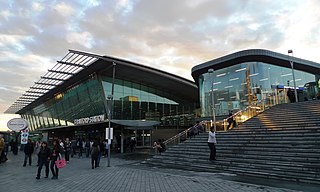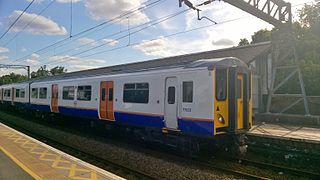
Trenitalia c2c Limited, trading as c2c, is an English train operating company owned by Trenitalia that operates the Essex Thameside railway franchise. It manages 25 stations and its trains call at 28. c2c provides commuter services from its London terminus as Fenchurch Street & Liverpool Street to east London and parts of Essex along the London, Tilbury and Southend Railway, and is the only operator on the line.

The North London line (NLL) is a railway line which passes through the inner suburbs of west, north west and north London, England between Richmond in the south-west and Stratford in the east, avoiding central London. Its route is a rough semicircle.

Stratford is a major multi-level interchange station serving the district of Stratford and the mixed-use development known as Stratford City, in the London Borough of Newham, east London. It is served by the London Underground, London Overground, Docklands Light Railway (DLR) and is also a National Rail station on the Great Eastern Main Line, 4 miles 3 chains (6.5 km) from Liverpool Street.

National Express East Anglia (NXEA) was a train operating company in England owned by National Express, that operated the Greater Anglia franchise from April 2004 until February 2012. Originally trading as One, it was rebranded National Express East Anglia in February 2008. It provided local, suburban and express services from London Liverpool Street to destinations in Essex, Hertfordshire, Cambridgeshire, Suffolk and Norfolk in the East of England.

The Great Eastern Main Line is a 114.5-mile (184.3 km) major railway line on the British railway system which connects Liverpool Street station in central London with destinations in east London and the East of England, including Shenfield, Chelmsford, Colchester, Ipswich, and Norwich. Its numerous branches also connect the main line to Southminster, Braintree, Sudbury, Harwich, and a number of coastal towns including Southend-on-Sea, Clacton-on-Sea, Walton-on-the-Naze and Lowestoft.

The London, Tilbury and Southend Railway (LTSR), also known as Essex Thameside, is a commuter railway line on the British railway system which connects Fenchurch Street station in central London with destinations in east London and Essex, including Barking, Upminster, Basildon, Grays, Tilbury, Southend and Shoeburyness.

Romford railway station is an interchange station on the Great Eastern Main Line, serving the town of Romford in the London Borough of Havering, east London. It is 12 miles 30 chains (19.9 km) down the line from London Liverpool Street and is situated between Chadwell Heath and Gidea Park. It is also the northern terminus of a branch line to Upminster operated by London Overground. Its three-letter station code is RMF and it is in Travelcard Zone 6.

The British Rail Class 321 alternating current (AC) electric multiple units (EMU) were built by British Rail Engineering Limited's York Works in three batches between 1988 and 1991. The design was successful and led to the development of the similar Class 320 and Class 322.

The Lea Valley lines are two commuter lines and two branches in North East London, so named because they run along the Lower Lea Valley of the River Lea. They were part of the Great Eastern Railway, now part of the Anglia Route of Network Rail.

The West Anglia Main Line is one of the two main lines from Liverpool Street, the other being the Great Eastern Main Line to Ipswich and Norwich. It runs generally north through Cheshunt, Broxbourne, Harlow, Bishop's Stortford and Audley End to Cambridge, with branches serving Stratford, Hertford and Stansted Airport. The line runs along the boundary between Hertfordshire and Essex for much of its length.

The Romford–Upminster line is a railway branch line in Greater London that connects Romford, on the Great Eastern Main Line, to Upminster, on the London, Tilbury and Southend Line and London Underground. The route is 3 miles 30 chains (5.4 km) in length and there is one intermediate station at Emerson Park. The line is part of Network Rail Strategic Route 7, SRS 07.09, and is classified as a rural line.

The Braintree branch line is a railway branch line in the East of England that diverges from the Great Eastern Main Line at Witham and runs north-west to Braintree. The route is 6 miles 30 chains (10.3 km) in length and there are five stations, including the two termini. The line is part of Network Rail Strategic Route 7, SRS 07.06, and is classified as a London and South-East commuter line.

The Ely–Peterborough line is a railway line in England, linking East Anglia to the Midlands. It is a part of the Network Rail Strategic Route 5, SRS 05.07 and is classified as a secondary line. It is used by a variety of inter-regional and local passenger services from East Anglia to the West Midlands and North West, as well as freight and infrastructure traffic; it also links with the busy East Coast Main Line at its western end. Fenland District council put forward their Rail Development Strategy for the route in 2012, which includes infrastructure upgrades for the intermediate stations, improved frequencies for the services using it and establishing a Community Rail Partnership for the line in 2013/14.

The Crouch Valley line is a branch line off the Shenfield–Southend line in Essex, in the east of England. It links Wickford in the west to Southminster in the east. The vast majority of services connect to or from the Great Eastern Main Line at Shenfield, and its London terminus at Liverpool Street.

The Shenfield–Southend line is a branch line off the Great Eastern Main Line in Essex, in the east of England. It links Shenfield in the west to Southend Victoria, in Southend-on-Sea, in the east. The vast majority of services connect to or from the Great Eastern Main Line and its London terminus at Liverpool Street.

Electrostar is the name given to a series of related electric multiple-unit (EMU) passenger trains manufactured by Bombardier Transportation at their Derby Litchurch Lane Works in England. Since the privatisation of British Rail, it has become the most common new EMU type in Britain, where different variants referred to as Class 357, Class 375, Class 376, Class 377, Class 378, Class 379 and Class 387, are most common on the high-volume suburban commuter routes in South, North and East London, and mainline services south to Surrey, Sussex, Kent & South Essex coasts and north to Cambridge and Stansted Airport. It shares the same bodyshell and core structure as the Turbostar, which is in turn the most common post-privatisation diesel multiple unit (DMU) family, and both evolved from the Class 168 Clubman design by ADtranz.
The Greater Anglia Route Utilisation Strategy is a Route Utilisation Strategy published by Network Rail in December 2007. It was the sixth RUS to be produced. The area covered includes the whole of Route 5 West Anglia (WA) and Route 7 Great Eastern (GE), which both focus for passenger purposes on London Liverpool Street, and the London Fenchurch Street services from Route 6. As with other RUSs, the Greater Anglia RUS took into account a number of responses, including the Office of Rail Regulation (ORR).
The Merseyside Route Utilisation Strategy is a Route Utilisation Strategy published by Network Rail in March 2009. It was the eleventh RUS to be produced. By default, RUSs are established by the Office of Rail Regulation (ORR) unless the latter objects within 60 days. The RUS is included in Network Rail's map as established.


















